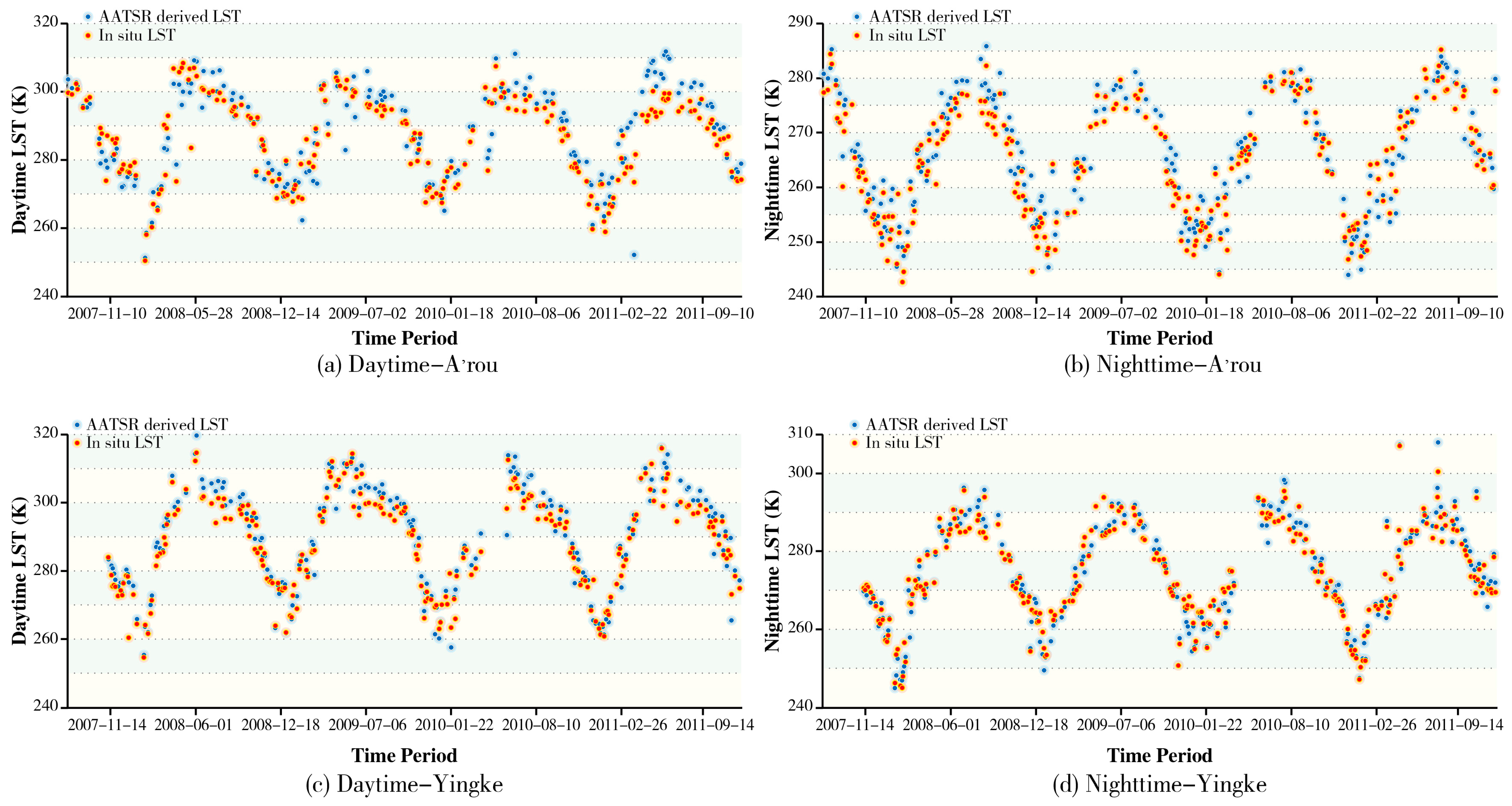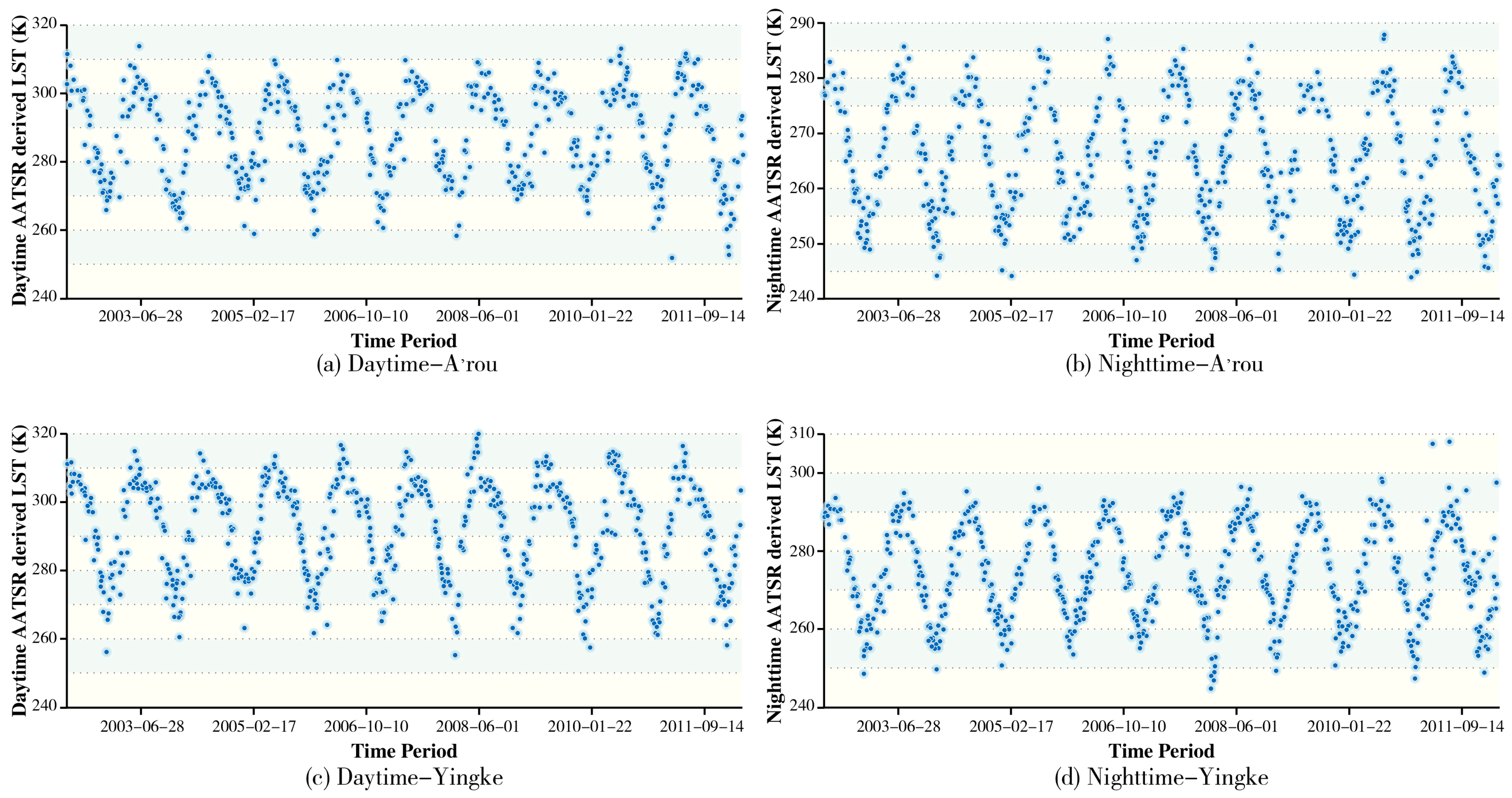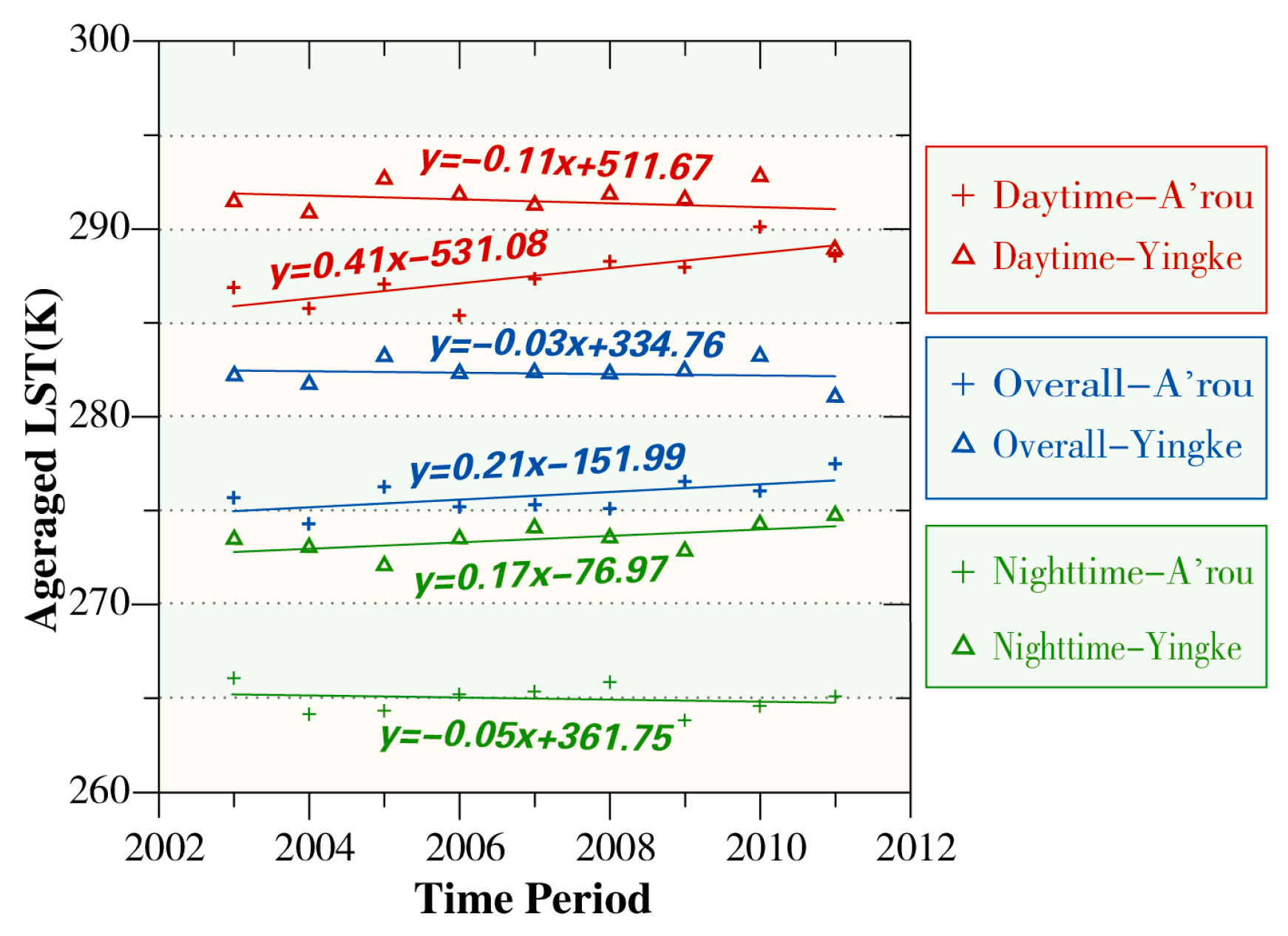Validation and Analysis of Long-Term AATSR Land Surface Temperature Product in the Heihe River Basin, China
Abstract
:1. Introduction
2. Materials and Methods
2.1. Study Area
2.2. AATSR LST Product
2.3. In Situ Measurements
2.4. Methods
2.4.1. Assessment of AATSR-Derived LST with in Situ Measurements over A’rou and Yingke for 2007–2011
2.4.2. Long-Term Variations of AATSR-Derived LST for 2003–2011
3. Results
3.1. Assessment of AATSR-Derived LST with In Situ Measurements over A’ron and Yingke for 2007–2011
3.1.1. Annual Analysis
3.1.2. Seasonal Analysis
3.2. Long-Term Variations of AATSR-Derived LST for 2003–2011
3.2.1. Two Sites Analysis
3.2.2. HRB Region Analysis
4. Discussion
4.1. Satellite Derived LST Validation
4.2. Temperature Trend in HRB
5. Conclusions
Acknowledgments
Author Contributions
Conflicts of Interest
References
- Brunsell, N.A.; Gillies, R.R. Length scale analysis of surface energy fluxes derived from remote sensing. J. Hydrometeorol. 2003, 4, 1212–1219. [Google Scholar] [CrossRef]
- Kustas, W.; Anderson, M. Advances in thermal infrared remote sensing for land surface modeling. Agric. For. Meteorol. 2009, 149, 2071–2081. [Google Scholar] [CrossRef]
- Li, Z.-L.; Tang, B.-H.; Wu, H.; Ren, H.; Yan, G.; Wan, Z.; Trigo, I.F.; Sobrino, J.A. Satellite-derived land surface temperature: Current status and perspectives. Remote Sens. Environ. 2013, 131, 14–37. [Google Scholar] [CrossRef]
- Cheng, J.; Liang, S.; Verhoef, W.; Shi, S.; Liu, Q. Estimating the Hemispherical Broadband Longwave Emissivity of Global Vegetated Surfaces using a Radiative Transfer Model. IEEE Trans. Geosci. Remote Sens. 2016, 54, 905–917. [Google Scholar] [CrossRef]
- Allen, M.R.; Mutlow, C.T.; Blumberg, G.M.C.; Christy, J.R.; McNider, R.T.; Llewellyn-Jones, D.T. Global change detection. Nature 1994, 370, 24–25. [Google Scholar] [CrossRef]
- Becker, F.; Li, Z.-L. Temperature-independent spectral indices in thermal infrared bands. Remote Sens. Environ. 1990, 32, 17–33. [Google Scholar] [CrossRef]
- Coll, C.; Caselles, V.; Sobrino, J.A.; Valor, E. On the atmospheric dependence of the split-window equation for land surface temperature. Int. J. Remote Sens. 1994, 15, 105–122. [Google Scholar] [CrossRef]
- Prata, A.J. Land surface temperatures derived from the advanced very high resolution radiometer and the along-track scanning radiometer 2. Experimental results and validation of AVHRR algorithms. J. Geophys. Res. 1994, 99, 13025–13058. [Google Scholar] [CrossRef]
- Wan, Z.; Dozier, J. A generalized split-window algorithm for retrieving land-surface temperature from space. IEEE Trans. Geosci. Remote Sens. 1996, 34, 892–905. [Google Scholar]
- Qin, Z.H.; Karnieli, A. A mono-window algorithm for retrieving land surface temperature from Landsat TM data and its application to the Israel–Egypt border region. Int. J. Remote Sens. 2001, 22, 3719–3746. [Google Scholar] [CrossRef]
- Tang, B.-H.; Bi, Y.; Li, Z.-L.; Xia, J. Generalized Split-Window algorithm for estimate of land surface temperature from Chinese geostationary FengYun meteorological satellite (FY-2C) data. Sensors 2008, 8, 933–951. [Google Scholar] [CrossRef] [PubMed]
- Atitar, M.; Sobrino, J.A. A split-window algorithm for estimating LST from Meteosat 9 data: Test and comparison with in situ data and MODIS LSTs. IEEE Geosci. Remote Sens. Lett. 2009, 6, 122–126. [Google Scholar] [CrossRef]
- Zhou, J.; Li, M.; Liu, S.; Jia, Z.; Ma, Y. Validation and Performance Evaluations of Methods for Estimating Land Surface Temperatures from ASTER Data in the Middle Reach of the Heihe River Basin, Northwest China. Remote Sens. 2015, 7, 7126–7156. [Google Scholar] [CrossRef]
- Kogler, C.; Pinnock, S.; Arino, O.; Casadio, S.; Corlett, G.; Prata, F.; Bras, T. Note on the quality of the (A)ATSR land surface temperature record from 1991 to 2009. Int. J. Remote Sens. 2011, 33, 4178–4192. [Google Scholar] [CrossRef]
- Galve, J.M.; Coll, C.; Prata, F. Monthly Land Surface Temperature Maps over European Zone Using Advanced along Track Scanning Radiometer Data for 2007. Available online: http://lst.nilu.no/Portals/73/Docs/Pubs/Galve_1317.pdf (accessed on 26 December 2016).
- Ghent, D.; Kaduk, J.; Remedios, J.; Ardö, J.; Balzter, H. Assimilation of land surface temperature into the land surface model JULES with an ensemble Kalman filter. J. Geophys. Res. 2010, 115, D19112. [Google Scholar] [CrossRef]
- ESA Land Surface Temperature Portal. Available online: http://lst.nilu.no/language/en-US/Home.aspx (accessed on 9 February 2016).
- Prata, A.J. Land Surface Temperature Measurement from Space: AATSR Algorithm Theoretical Basis Document; CSIRO Atmospheric Research: Aspendale, Australia, 2002. [Google Scholar]
- Coll, C.; Caselles, V.; Galve, J.M.; Valor, E.; Niclos, R.; Sanchez, J.M.; Rivas, R. Ground measurements for the validation of land surface temperatures derived from AATSR and MODIS data. Remote Sens. Environ. 2005, 97, 288–300. [Google Scholar] [CrossRef]
- Coll, C.; Caselles, V.; Galve, J.M.; Valor, E.; Niclo’s, R.; Sa’nchez, J.M. Evaluation of split-window and dual-angle correction methods for land surface temperature retrieval from Envisat/Advanced Along Track Scanning Radiometer (AATSR) data. J. Geophys. Res. 2006, 111, D12105. [Google Scholar] [CrossRef]
- Noyes, E.; Corlett, G.; Remedios, J.; Kong, X.; Llewellyn-Jones, D. An accuracy assessment of AATSR LST data using empirical and theoretical methods. In Proceedings of the Envisat Symposium, Montreux, Switzerland, 23–27 April 2007.
- Sòria, G.; Sobrino, J.A. ENVISAT/AATSR derived land surface temperature over a heterogeneous region. Remote Sens. Environ. 2007, 111, 409–422. [Google Scholar] [CrossRef]
- Coll, C.; Caselles, V.; Galve, J.M.; Mira, M.; Bisquert, M.; Vicente, G.-S. Long-term accuracy assessment of land surface temperatures derived from the Advanced Along-Track Scanning Radiometer. Remote Sens. Environ. 2012, 116, 211–225. [Google Scholar] [CrossRef]
- Schneider, P.; Ghent, D.; Corlett, G.; Prata, F.; Remedios, J. AATSR Validation: LST Validation Protocol; University of Leicester: Leicester, UK, 2012. [Google Scholar]
- Wan, Z.; Zhang, Y.; Zhang, Q.; Li, Z.-L. Validation of the land-surface temperature products retrieved from Terra Moderate Resolution Imaging Spectroradiometer data. Remote Sens. Environ. 2002, 83, 163–180. [Google Scholar] [CrossRef]
- Ghent, D. Land Surface Temperature Validation and Algorithm Verification; Report to European Space Agency; European Space Agency: Paris, France, 2012. [Google Scholar]
- Li, X.; Li, X.; Li, Z.; M, M.; Wang, J.; Qiao, X.; Liu, Q.; Che, T.; Chen, E.; Yan, G.; et al. Watershed allied telemetry experimental research. J. Geophys. Res. 2009, 114, D22103. [Google Scholar] [CrossRef]
- ESA DUE GlobTemperature Project. Available online: http://www.globtemperature.info/ (accessed on 16 August 2015).
- Llewellyn-Jones, D.; Edwards, M.; Mutlow, C.; Birks, A.; Barton, I.; Tait, H. AATSR: Global-change and surface-temperature measurements from ENVISAT. ESA Bull. 2001, 105, 10–21. [Google Scholar]
- Hu, Z.; Ma, M.; Jin, R.; Wang, W.; Huang, G.; Zhang, Z.; Tan, J. WATER: Dataset of Automatic Meteorological Observations at the A’rou Freeze/Thaw Observation Station; Cold and Arid Regions Environmental and Engineering Research Institute, Chinese Academy of Sciences: Beijing, China, 2008. [Google Scholar]
- Cheng, J.; Liang, S.; Yao, Y.; Zhang, X. Estimating the Optimal Broadband Emissivity Spectral Range for Calculating Surface Longwave Net Radiation. IEEE Geosci. Remote Sens. Lett. 2013, 10, 401–405. [Google Scholar] [CrossRef]
- Sobrino, J.A.; Jiménez-Muñoz, J.C.; Sòria, G.; Ruescas, A.B.; Danne, O.; Brockmann, C.; Ghent, D.; Remedios, J.; North, P.; Merchant, C.; et al. Synergistic use of MERIS and AATSR as a proxy for estimating Land Surface Temperature from Sentinel-3 data. Remote Sens. Environ. 2016, 179, 149–161. [Google Scholar] [CrossRef]
- El Niño and La Niña Years and Intensities Based on Oceanic Niño Index (ONI). Available online: http://ggweather.com/enso/oni.htm (accessed on 25 November 2016).
- Vinnikov, K.Y.; Robock, A.; Grody, N.C.; Basist, A. Analysis of diurnal and seasonal cycles and trends in climatic records with arbitrary observation times. Geophys. Res. Lett. 2004, 31, L06205. [Google Scholar] [CrossRef]
- Jin, M.; Mullens, T.J. Land-biosphere-atmosphere interactions over the Tibetan plateau from MODIS observations. Environ. Res. Lett. 2012, 7, 014003. [Google Scholar] [CrossRef]
- Zhan, W.; Chen, Y.; Zhou, J.; Wang, J.; Liu, W.; Voogt, J.; Zhu, X.; Quan, J.; Li, J. Disaggregation of remotely sensed land surface temperature: Literature survey, taxonomy, issues, and caveats. Remote Sens. Environ. 2013, 131, 119–139. [Google Scholar] [CrossRef]
- Luo, K.; Tao, F.; Miowo, J.P.; Xiao, D. Attribution of hydrological change in Heihe River Basin to climate and land use change in the past three decades. Sci. Rep. 2016, 6, 33704. [Google Scholar] [CrossRef] [PubMed]
- Li, Z.; Wang, X. Shift trend analysis of meteorological time series in the upper and middle reaches of Heihe River Basin. Geogr. Res. 2011, 9, 2059–2066. (In Chinese) [Google Scholar]







| Site | Latitude | Longitude | Elevation (m) | Land Cover | Time Period | Samples |
|---|---|---|---|---|---|---|
| A’rou | 38°03′N | 100°27′E | 3032.8 | Alpine meadow | August 2007~November 2011 | 461 |
| Yingke | 38°51′N | 100°25′E | 1519 | Cropland (Maize) | November 2007~November 2011 | 477 |
| Year | A’rou | Yingke | |||||||||||||||||||
|---|---|---|---|---|---|---|---|---|---|---|---|---|---|---|---|---|---|---|---|---|---|
| Daytime | Nighttime | Daytime | Nighttime | ||||||||||||||||||
| N | Bias (K) | STD (K) | RMSE (K) | R2 | N | Bias (K) | STD (K) | RMSE (K) | R2 | N | Bias (K) | STD (K) | RMSE (K) | R2 | N | Bias (K) | STD (K) | RMSE (K) | R2 | ||
| 2008 | 51 | 0.22 | 4.93 | 4.89 | 0.89 | 67 | 2.71 | 3.08 | 4.09 | 0.91 | 55 | 2.25 | 2.33 | 3.22 | 0.98 | 64 | 0.41 | 2.54 | 2.55 | 0.97 | |
| 2009 | 52 | 0.15 | 4.69 | 4.64 | 0.86 | 46 | 1.26 | 3.30 | 3.50 | 0.89 | 61 | 1.33 | 2.79 | 3.07 | 0.97 | 58 | −0.80 | 3.33 | 3.39 | 0.93 | |
| 2010 | 43 | 2.08 | 4.66 | 5.06 | 0.86 | 53 | 0.50 | 2.59 | 2.62 | 0.94 | 48 | 1.78 | 3.69 | 4.06 | 0.94 | 55 | 0.26 | 1.68 | 2.74 | 0.95 | |
| 2011 | 49 | 5.61 | 6.32 | 8.41 | 0.83 | 48 | 0.65 | 3.27 | 3.30 | 0.92 | 51 | 1.44 | 3.27 | 3.54 | 0.96 | 61 | 0.73 | 1.54 | 2.33 | 0.97 | |
| 2007–2011 | 217 | 1.57 | 5.60 | 5.80 | 0.82 | 244 | 1.19 | 3.32 | 3.52 | 0.90 | 227 | 1.77 | 3.12 | 3.58 | 0.96 | 250 | 0.15 | 2.74 | 2.74 | 0.96 | |
| Season | A’rou | Yingke | |||||||||||||||||||
|---|---|---|---|---|---|---|---|---|---|---|---|---|---|---|---|---|---|---|---|---|---|
| Daytime | Nighttime | Daytime | Nighttime | ||||||||||||||||||
| N | Bias (K) | STD (K) | RMSE (K) | R2 | N | Bias (K) | STD (K) | RMSE (K) | R2 | N | Bias (K) | STD (K) | RMSE (K) | R2 | N | Bias (K) | STD (K) | RMSE (K) | R2 | ||
| Winter | 56 | 0.86 | 4.36 | 4.40 | 0.63 | 54 | 1.63 | 3.47 | 3.80 | 0.48 | 65 | 0.51 | 3.41 | 3.42 | 0.83 | 75 | −1.06 | 2.95 | 3.11 | 0.79 | |
| Spring | 55 | 0.80 | 8.30 | 9.26 | 0.55 | 57 | 0.28 | 3.21 | 3.19 | 0.75 | 42 | 0.73 | 2.79 | 2.85 | 0.93 | 57 | −0.65 | 2.31 | 2.38 | 0.93 | |
| Summer | 42 | 4.6 | 4.42 | 6.34 | 0.20 | 42 | 1.90 | 2.49 | 3.11 | 0.36 | 51 | 4.20 | 2.54 | 4.89 | 0.76 | 55 | 1.60 | 2.70 | 3.12 | 0.60 | |
| Autumn | 52 | 1.73 | 2.93 | 3.42 | 0.87 | 54 | 1.91 | 3.25 | 3.75 | 0.78 | 68 | 1.72 | 2.39 | 2.93 | 0.93 | 62 | 1.17 | 1.89 | 2.21 | 0.93 | |
| Year | A’rou | Yingke | ||||
|---|---|---|---|---|---|---|
| Daytime | Nighttime | Overall | Daytime | Nighttime | Overall | |
| 2003 | 48 | 56 | 104 | 60 | 64 | 124 |
| 2004 | 54 | 61 | 115 | 61 | 64 | 125 |
| 2005 | 62 | 56 | 118 | 66 | 56 | 122 |
| 2006 | 50 | 51 | 101 | 58 | 63 | 121 |
| 2007 | 53 | 64 | 117 | 62 | 67 | 129 |
| 2008 | 47 | 67 | 114 | 63 | 69 | 132 |
| 2009 | 52 | 47 | 99 | 61 | 58 | 119 |
| 2010 | 53 | 65 | 118 | 58 | 62 | 120 |
| 2011 | 59 | 53 | 112 | 56 | 70 | 126 |
| Year | Day_Averaged_LST | Night_Averaged_LST | Day-Night_Averaged LST |
|---|---|---|---|
| 2003 | −0.06 | 0.03 | −1.09 |
| 2004 | 0.92 | 0.17 | 0.67 |
| 2005 | 1.14 | −0.83 | 0.87 |
| 2006 | −0.03 | 0.49 | −0.24 |
| 2007 | 0.07 | 0.83 | 0.19 |
| 2008 | −0.20 | 0.08 | 0.27 |
| 2009 | 0.10 | −0.53 | 0.55 |
| 2010 | 1.10 | 1.06 | −0.77 |
| 2011 | −0.68 | −0.67 | 0.27 |
© 2017 by the authors. Licensee MDPI, Basel, Switzerland. This article is an open access article distributed under the terms and conditions of the Creative Commons Attribution (CC BY) license ( http://creativecommons.org/licenses/by/4.0/).
Share and Cite
Ouyang, X.; Chen, D.; Duan, S.-B.; Lei, Y.; Dou, Y.; Hu, G. Validation and Analysis of Long-Term AATSR Land Surface Temperature Product in the Heihe River Basin, China. Remote Sens. 2017, 9, 152. https://doi.org/10.3390/rs9020152
Ouyang X, Chen D, Duan S-B, Lei Y, Dou Y, Hu G. Validation and Analysis of Long-Term AATSR Land Surface Temperature Product in the Heihe River Basin, China. Remote Sensing. 2017; 9(2):152. https://doi.org/10.3390/rs9020152
Chicago/Turabian StyleOuyang, Xiaoying, Dongmei Chen, Si-Bo Duan, Yonghui Lei, Youjun Dou, and Guangcheng Hu. 2017. "Validation and Analysis of Long-Term AATSR Land Surface Temperature Product in the Heihe River Basin, China" Remote Sensing 9, no. 2: 152. https://doi.org/10.3390/rs9020152
APA StyleOuyang, X., Chen, D., Duan, S.-B., Lei, Y., Dou, Y., & Hu, G. (2017). Validation and Analysis of Long-Term AATSR Land Surface Temperature Product in the Heihe River Basin, China. Remote Sensing, 9(2), 152. https://doi.org/10.3390/rs9020152









